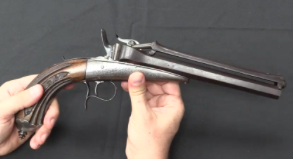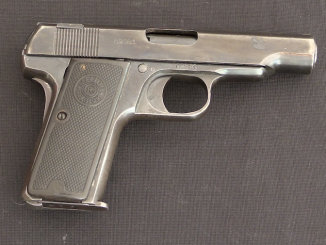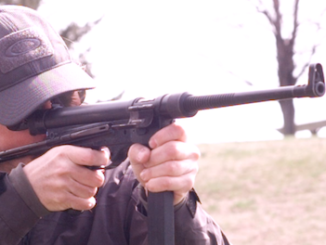It seems like everyone is making a copy of the Browning High Power these days, and FN themselves have jumped into the arena as well. What FN is making isn’t just a clone of the original pistol, though – they have built something largely new, taking inspiration and design cues from the original BHP to create a gun more suited to 2022 than 1935.
While the original High Power (or Hi Power, depending on what era you are looking at) is lovingly romanticized by many – and I totally understand why – it has a number of significant shortcomings by today’s standards. It doesn’t feed hollow points well. The triggers are often bad, in part because of the magazine safety. The sights are tiny. The capacity is underwhelming. And most significantly to me, they tend to have bloody hammer bite, forcing you to take a low grip or just suffer through.
The new FN High Power looks to have fixed all of that. It’s a bigger pistol, but it offers a much more comfortable grip, modern style sights, a very nice single action trigger, and 17 round capacity (it does not interchange magazines with the original BHP). Let’s take a closer look at what FN did, and why…




I love modern take son old autoloaders
12:44 Jesus, WHAT?! a FLAT mainspring on an original Hi-Power?? Fatigue bites 🙂
Not to contradict you about longevity but flat springs were fine for so many revolvers, the 1903 Browning and Colt, and even Makarov. Is it a question of fatigue or the amount of material they use compared to coil springs?
I have read that Browning was really quite proud of that transfer lever in the slide; it doubled as an out-of-battery safety and disconnector, used less metal than any regular trigger bar, and considering that his first designs were striker-fired (the transfer bar acting as a direct sear) would have probably resulted in a nifty trigger-pull. I note that in the new version the bar is kinked to press down on the middle of the sear — I’ll bet that geometry is what makes for this gun’s quality trigger-pull, er, press, uh, actuation.
Your not first to be concerned about spring life.
Kretz elected to use clockwork springs
https://guns.fandom.com/wiki/Kretz_rifle
his design was found too complicated for average 1910s British soldier
The major reason for the transfer bar in the slide was to avoid a stirrup-type trigger geometry as on the 1911. Browning felt that with a double-column magazine the 1911-type trigger would have made the grip too wide.
He probably would not be a fan of modern “widebody” high-capacity autopistols like the Glocks.
cheers
eon
Mainspring is definitely a coil, in the usual place in the heel of the grip
A needless effort…
GP35 is an iconic sample of the era when produced and… Better handguns have been made therefter like CZ75…
IMHO.
No, they have not. I own two – a 1930’s antique and a 1976 model with target sights – they are accurate, reliable, I’ve never gotten hammer bite and if you need more than 13 rounds you either badly miscalculated or need marksmanship training. And there is the appeal of blued steel and walnut grips.
“(…)Better handguns have been made(…)”
“(…)not(…)”
Main problem here how do you define/measure better.
Not since they turned plastic.
Well, if we remember one of the prototype was designed to accommodate 15 rounds..
Correct, CZ75 looks far better, even Beretta does (those with rotary barrel). You have to wonder why FN even conceived this “quasi-replica”. To me it indicates that they are way behind SIG and are not happy about it. Let’s accept the truth, competition is nasty.
I mean… This gun has most of desired hits for a current 9mm but… It is not a HP…
If you want one of the new ones, buy one now, I don’t expect it’s a long-lived gun.
I get they wanted to build a more modern pistol, but it’s only half modern. If you’re going to re-engineer the fire control group, why run the transfer bar through the slide? If you’re putting a longer grip, why not make the magazines compatible w/ the older guns even if they stick out? Where’s the optic cut? The dust cover rail? Everyone’s got to buy new holsters anyway b/c she’s THIC now.
I’ve been utterly wrong before, I just don’t see why someone who wants to shoot a HiPower for fun would buy an FN that is a HiPower in name only, versus a Turkish clone that is parts compatible w/ the originals.
“(…)I just don’t see why someone who wants to shoot a HiPower for fun would buy an FN that is a HiPower in name only, versus a Turkish clone that is parts compatible w/ the originals.”
So… Fabrique Nationale’s market analysis malfunctioned in this case I would not profit be above cost? If yes why this might be?
Fabrique Nationale is no more the name of the company. This is FN Herstal.
By the way, the new HiPower is a product of FN America, the US subsidiary of FN Herstal. The mother company is betting on its own new pistol, the HiPer.
The old HP has a COIL hammer spring, a flat spring for the sear, conceptually much like the 1911, although the parts are very different. Somehow that fat, ugly slide, and fat grip doesn’t impress. Both the 1911 and original HP have some of the narrowest slides ever seen in those calibers. G19’s have 15 rounds, any old HP will take 15 rd mags, should be fine.
It doesn’t seem like any real improvement, other than the hammer bite issue. Springfield’s new version has an extended tang, solving the one real ergo issue of the gun. The original HP grip was THE most favored grip by the widest range of people, IME. Women like it, men like it …..that is extremely rare. CZ essentially copied the HP grip in the CZ75, a smart move.
My bet is that the Springfield version outsells the FN version six or ten to one.
Oh shapers stull in use in a production setting?
I would love to have seen that
There’s an adage amongst machine shop people, that you can make almost anything on a shaper
– but money
Those old machines are long gone. The machining shop Ian remembers was partially demolished some years ago to be replaced by a new assembly line for remote weapon stations and vehicle/aerial mounts.
The remaining part of that building now houses the John Moses Browning Collection workshop, formerly known as the Browning Custom Shop.
This has become an internet machinist meme in last years, just like “definition of insanity…” quote that gets copy pasted all over.
(…)FN’s New High Power(…)
Wait, new fire-arms based on decade-old design… I did see something like this recently, though bigger: LASKA https://modernfirearms.net/en/machineguns/ukraine-machineguns/snipex-laska-k-2-2/
…clear Browning heritage. Its slab-sided, pinned receiver, dual spade grips, feed unit and recoiling barrel arrangements are heavily based on the century-old Browning M1921 / M2HB heavy machine gun. However, there are numerous deviations from the old design, which may or may not help to improve this particular weapon.
So there are 2 cases which might be coincidence, do you know of any recent, current or near-future other cases of deriving new fire-arm from decades old design.
The main shortcoming of the “new” High Power is in my view the use of the ejection port in the slide as a locking surface. I would not call this modern, in the sense of being better than “old” solutions, but simply a weak solution exclusively adopted for its cheapness. Neither Browning nor Saive ever used it.
The “fat” shape also drops one of the best features of the original. I personally never had any problems with hammer bite. The FN High Powers I had the pleasure to shoot were very accurate pistols.
I do not believe in high capacity magazines. Recently, a German police officer was murdered by a poacher, after the officer had fired 20 rounds from his pistol without a single hit. All this happened at the typical ranges after pulling over a suspect automobile. High capacity magazines in my view are not only heavy, but also counter-productive regarding placing aimed shots.
If I ever got into a firefight, I would pray that my opponent has a high capacity magazine, seducing him to bang away one unaimed shot after the other, as he has seen on the Internet all the time. Beware of the opponent who thinks that a firefight should be over after 2 or 3 rounds.
So TRUE, from top to bottom.
Do have 2 High Powers, one WWII collectable and a 1970’s era stainless. Yes, the sights are miniscule, but functional. Will probably catch a lot of “flak”, but I did remove the magazine disconnect from my newer one and shoot / carry it regularly. Trigger pull is much better, and have not had a problem with hammer bite or feeding hollow points. Hornadys Critical defense rounds work extremely well. Do have some newer pistols also, but do like my High Powers.
I’m seeing a single-action rendition of the Walther P88. Which didn’t sell very well.
As for “hammer bite”, I’ve never used the “IPSC” fashionable high grip; the HP was designed for a lower grip, more like a revolver. And I’ve always had burr hammers, not spur hammers. No HP so configured has drawn blood from me, or even bruised me, yet.
I have, however, gotten scars from spur-hammered 1911s, especially the supposedly legendary MK IV Series 70 version, with what can only be defined as the Square-Edged Hammer From Hell on its rear end. The absolute first thing any 1911 set up for serious use needs is both a Commander-type burr hammer and an extended grip safety “spoon” tang. But I digress.
If they really wanted to “modernize” the HP, they could have gone with a polymer frame (which would have made that separate backstrap setup easier and cheaper to make) and a more modern “safe action” trigger while retaining the option of Condition One carry with the ambidextrous thumb safety.
Of course, what they would have had then would be an exposed-hammer-fired version of the SiG P320 aka U.S. M17 and M19. Which has always looked to me like what John Browning would do to the HP if he were still around today.
The dirty little secret of the High Power has always been that it was Browning’s way of taking the Colt 1911 back to the drawing board, simplifying it, and eliminating all the unneeded frippery that U.S. Army Ordnance demanded. Like that fundamentally useless grip safety, and the .45 cartridge that hit no “harder” than the 9 x 19mm and made a high-capacity magazine a colossal PITA to design.
Basically, the High Power is what the Colt 1911 would have looked like in 1910 if the U.S. Army had actually effing listened to John Moses Browning at the time.
Today, as I said, his “reimagining” of his and Saive’s classic design would very likely look more like a SiG M17, or a S&W M&P.
A bulkier, single-action-only rendition of a Walther P88? Umm, no, I don’t think so.
cheers
eon
I like the new sights, otherwise I dislike this fat pistol. Larger magazine capacity does not impress me; 13 was enough in my older, very accurate and superbly dependable FN HP. I don’t like the lock-up or that debris-hole in the slide. Never had hammer-bite. I’m not a fan of this iteration of “New and Improved”.
I like it. The trend to remake older designs using modern manufacturing is so far awesome – I have one of the new Colt Pythons and Sig p210 and they’re way more both affordable and as nice as the original.
It looks like FN and SIG screwed and had a retarded, fat child.
I don’t hate it, but honestly other than as a marketing ploy for FN, is there any need for it. It’s a bigger, chunkier kinda-sorta HiPower. If anyone wanted such a thing there are at least fifty alternatives already on the market.
No I’ll will to anyone who wants one, but the new HiPower isn’t for me
The minute I saw that removable back strap, my first thought was you could make one with a stock cut. That would be interesting but of course the evil overlords would never allow it, at least not without a ton of painful paperwork and a tax (at least here in the USA).
The two things that made me choose a 1976 target High Power as my first full bore pistol were the grip fit in my hand and the svelte and graceful lines. I find it quite acceptable as a carry gun.
I’ll get an SA35 when the prices drop to MSRP or below.
The extra capacity is unwelcome. My Glock 19 came with one short mag and two long mags. I’m hoping I can swap the long ones for short ones. If 15 rounds aren’t enough you should practice more.
For a very long time I wouldn’t even consider a fat ugly Glock. It was only having a LaserLyte that motivated getting the 19. After shooting metric IPSC targets with reflective A zones scaled from 24 to 200 ft for 15-20 minutes a day and getting to where I could consistently hit the A section on the 200 ft target I decided that the Glock would make an acceptable house gun.
“(…)fit in my hand(…)”
https://www.guntweaks.com/pistol-bore-axis-comparison-what-is-low-bore-axis.html did measure something they are calling Alignment Index and found value around 1.0 to be desirable, Browning High Power Mk III has one equal to 1.01 which is very near to 1.0
I had a re-parked canadian version of the FN. It was a nice looking (rather bright?)
green with all manner of rust pitting underneath.
When you started to pull the trigger, you could see the slide assembly torque to the left
– CCW. Who wants that kind of nonsense?
I was not impressed.
I sold it for what I paid for it.
…
The inevitable magazine capacity argument- how many rounds do you need if you can shoot during stress situations? I use a Walther P1 8 round magazine from the start. I prefer a S&W model 637 airweight .38 special for edc firearm. +p rated and easiest gun to point and shott with a high level of hits I ever shot.
I do like coil springs, it’s easy to get the desired surface finish, work hardening and a locked in state of compressive stress in the surface of the metal to resist fatigue, just through the wire drawing process.
However, correctly designed and correctly finished (those qualifications are essential) leaf or a v springs are not necessarily more prone to fatigue than a coil spring…
note the continuing use of leaf springs in settings where durability and low maintenance are essential, such as heavy vehicle and rail goods wagon suspensions.
In gun lock work there are some significant advantages to using v springs with a stirrup attachment to the hammer,
These include weight and lock time.
It is certainly possible to design shotgun and break action rifle locks with coil springs, yet the high end guns in both mass production line guns like Perazzi, and the bespoke guns from the likes of Westley Richards, Holland and Holland, and Purdey, and their continental peers, use flat and V springs.
In the case of Perazzi, there is no company tradition or design heritage going back into the early 20th century or before. The v springs are there on merit alone.
“…where durability and low maintenance are essential.” E.g. Makarov? I am still impressed with that spring’s multi-functionality: mainspring, magazine catch, and I think sear spring too.
Very late thought: Is there a firing pin block? Is it safe to carry the old P35, or the new one, cocked and locked? To what extent are they drop-safe and how?
Illinois State police carried browning high powers in the 60s and 70 so they must’ve been good guns
Illinois State Police started with the S&W model 39, which looks something like the B-HP w makes sense for with an 8 round single stack magazine in the 1950s so switching to a higher capacity magazine except that the Model 39 is a da/sa format based on the Walther P38.